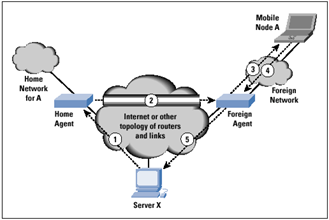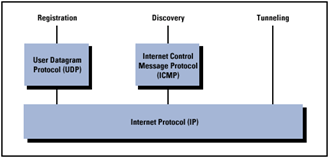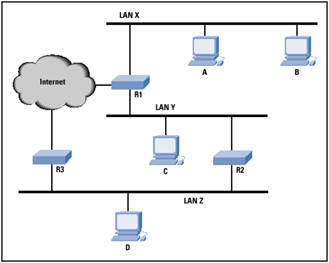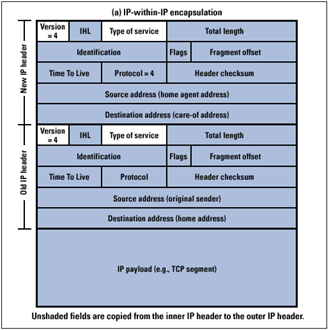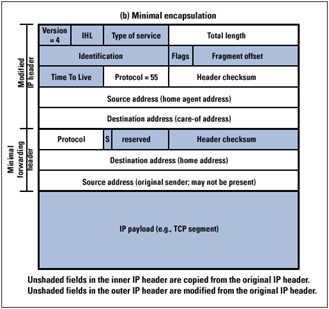| 1. |
Server X transmits an IP datagram destined for mobile node A, with A's home address in the IP header. The IP datagram is
routed to A's home network.
|
| 2. |
At the home network, the incoming IP datagram is intercepted by the home agent. The home agent encapsulates the entire
datagram inside a new IP datagram, which has the A's care-of address in the header, and retransmits the datagram. The use of
an outer IP datagram with a different destination IP address is known as tunneling.
|
| 3. |
The foreign agent strips off the outer IP header, encapsulates the original IP datagram in a network-level Protocol Data
Unit (PDU) (for example, a LAN Logical Link Control [LLC] frame), and delivers the original datagram to A
across the foreign network.
|
| 4. |
When A sends IP traffic to X, it uses X's IP address. In our example, this is a fixed address; that is, X is not a mobile
node. Each IP datagram is sent by A to a router on the foreign network for routing to X. Typically, this router is also the
foreign agent.
|
| 5. |
The IP datagram from A to X travels directly across the Internet to X, using X's IP address.
|
 |
Discovery: A mobile node uses a discovery procedure to identify prospective home agents and foreign agents.
|
 |
Registration: A mobile node uses an authenticated registration procedure to inform its home agent of its care-of address.
|
 |
Tunneling: Tunneling is used to forward IP datagrams from a home address to a care-of address.
|
 |
Type: 16, indicates that this is an agent advertisement.
|
 |
Length: (6 + 4N ), where N is the number of care-of addresses advertised.
|
 |
Sequence number: The count of agent advertisement messages sent since the agent was initialized.
|
 |
Lifetime: The longest lifetime, in seconds, that this agent is willing to accept a registration request from a mobile node.
|
 |
R: Registration with this foreign agent is required (or another foreign agent on this network). Even those mobile
nodes that have already acquired a care-of address from this foreign agent must reregister.
|
 |
B: Busy. The foreign agent will not accept registrations from additional mobile nodes.
|
 |
H: This agent offers services as a home agent on this network.
|
 |
F: This agent offers services as a foreign agent on this network.
|
 |
M : This agent can receive tunneled IP datagrams that use minimal encapsulation, explained subsequently.
|
 |
G: This agent can receive tunneled IP datagrams that use Generic Routing Encapsulation (GRE), explained
subsequently.
|
 |
Y: This agent supports the use of Van Jacobson header compression, an algorithm defined in RFC 1144 for compressing
fields in the TCP and IP headers.
|
 |
Care-of address: The care-of address or addresses supported by this agent on this network. There must be at least
one such address if the F bit is set. There may be multiple addresses.
|
 |
Type: 19, indicates that this is a prefix-length advertisement.
|
 |
Length: N, where N is the value of the Num Addrs field in the ICMP router advertisement portion of this
ICMP message. In other words, this is the number of router addresses listed in this ICMP message.
|
 |
Prefix length: The number of leading bits that define the network number of the corresponding router address listed
in the ICMP router advertisement portion of this message. The number of prefix length fields matches the number of router
address fields (N).
|
 |
Use of Lifetime field: When a mobile node receives an agent advertisement from a foreign agent that it is currently
using or that it is now going to register with, it records the Lifetime field as a timer. If the timer expires before the
agent receives another agent advertisement from the agent, then the node assumes that it has lost contact with that agent.
If, in the meantime, the mobile node has received an agent advertisement from another agent and that advertisement has not
yet expired, the mobile node can register with this new agent. Otherwise, the mobile node should use agent solicitation to
find an agent.
|
 |
Use of network prefix: The mobile node checks whether any newly received agent advertisement is on the same network
as the current care-of address of the node. If it is not, the mobile node assumes that it has moved and may register with the
agent whose advertisement the mobile node has just received.
|
| 1. |
The mobile node requests the forwarding service by sending a registration request to the foreign agent that the mobile node
wants to use.
|
| 2. |
The foreign agent relays this request to the home agent of that mobile node.
|
| 3. |
The home agent either accepts or denies the request and sends a registration reply to the foreign agent.
|
| 4. |
The foreign agent relays this reply to the mobile node.
|
 |
Type: 1, indicates that this is a registration request.
|
 |
S : Simultaneous bindings. The mobile node is requesting that the home agent retain its prior mobility bindings.
When simultaneous bindings are in effect, the home agent will forward multiple copies of the IP datagram, one to each care-of
address currently registered for this mobile node. Multiple simultaneous bindings can be useful in wireless handoff
situations to improve reliability.
|
 |
B: Broadcast datagrams. Indicates that the mobile node would like to receive copies of broadcast datagrams that it
would have received if it were attached to its home network.
|
 |
D: Decapsulation by mobile node. The mobile node is using a colocated care-of address and will decapsulate its own
tunneled IP datagrams.
|
 |
M: Indicates that the home agent should use minimal encapsulation, explained subsequently.
|
 |
V: Indicates that the home agent should use Van Jacobson header compression, an algorithm defined in RFC 1144 for
compressing fields in the TCP and IP headers.
|
 |
G: Indicates that the home agent should use GRE encapsulation, explained subsequently.
|
 |
Lifetime : The number of seconds before the registration is considered expired. A value of zero is a request for
deregistration.
|
 |
Home address: The home IP address of the mobile node. The home agent can expect to receive IP datagrams with this as
a destination address, and must forward those to the care-of address.
|
 |
Home agent: The IP address of the mobile node home agent. This informs the foreign agent of the address to which
this request should be relayed.
|
 |
Care-of address: The IP address at this end of the tunnel. The home agent should forward IP datagrams that it
receives with the mobile node home address to this destination address.
|
 |
Identification: A 64-bit number generated by the mobile node, used for matching registration requests to
registration replies and for security purposes, as explained subsequently.
|
 |
Extensions: The only extension so far defined is the authentication extension, explained subsequently.
|
 |
Type: 3, indicates that this is a registration reply.
|
 |
Code: Indicates result of the registration request.
|
 |
Lifetime: If the code field indicates that the registration was accepted, the number of seconds before the
registration is considered expired. A value of zero indicates that the mobile node has been deregistered.
|
 |
Home address: The home IP address of the mobile node.
|
 |
Home agent : The IP address of the mobile node home agent.
|
 |
Identification: A 64-bit number used for matching registration requests to registration replies.
|
| 1. |
A node may pretend to be a foreign agent and send a registration request to a home agent so as to divert traffic intended for
a mobile node to itself.
|
| 2. |
A malicious agent may replay old registration messages, effectively cutting the mobile node from the network.
|
 |
Type: Used to designate the type of this authentication extension.
|
 |
Length: 4 plus the number of bytes in the authenticator.
|
 |
Security parameter index (SPI): An index that identifies a security context between a pair of nodes. This security
context is configured so that the two nodes share a secret key and parameters relevant to this association (for example,
authentication algorithm).
|
 |
Authenticator: A code used to authenticate the message. The sender inserts this code into the message using a shared
secret key. The receiver uses the code to ensure that the message has not been altered or delayed. The authenticator protects
the entire registration request or reply message, any extensions prior to this extension, and the type and length fields of
this extension.
|
 |
Mobile-home: This extension must be present and provides for authentication of the registration messages between the
mobile node and the home agent.
|
 |
Mobile-foreign: The extension may be present when a security association exists between the mobile node and the
foreign agent. The agent will strip this extension off before relaying a request message to the home agent and add this
extension to a reply message coming from a home agent.
|
 |
Foreign-home: The extension may be present when a security association exists between the foreign agent and the home
agent.
|
 |
IP-within-IP encapsulation: This is the simplest approach, defined in RFC 2003.
|
 |
Minimal encapsulation: This approach involves fewer fields, defined in RFC 2004.
|
 |
Generic routing encapsulation (GRE): This is a generic encapsulation procedure, defined in RFC 1701, that was
developed prior to the development of Mobile IP.
|
 |
Protocol: Copied from the Destination Address field in the original IP header. This field identifies the protocol
type of the original IP payload and thus identifies the type of header that begins the original IP payload.
|
 |
S: If 0, the original source address is not present, and the length of this header is 8 octets. If 1, the original
source address is present, and the length of this header is 12 octets.
|
 |
Header checksum: Computed over all the fields of this header.
|
 |
Original destination address: Copied from the Destination Address field in the original IP header.
|
 |
Original source address: Copied from the Source Address field in the original IP header. This field is present only
if the S bit is 1. The field is not present if the encapsulator is the source of the datagram (that is, the datagram
originates at the home agent).
|
 |
Total length: Incremented by the size of the minimal forwarding header (8 or 12).
|
 |
Protocol : 55; this is the protocol number assigned to minimal IP encapsulation.
|
 |
Header checksum: Computed over all the fields of this header; because some of the fields have been modified, this
value must be recomputed.
|
 |
Source address: The IP address of the encapsulator, typically the home agent.
|
 |
Destination address: The IP address of the exit point of the tunnel. This is the care-of address and may be either
the IP address of the foreign agent or the IP address of the mobile node (in the case of a colocated care-of address).
|



